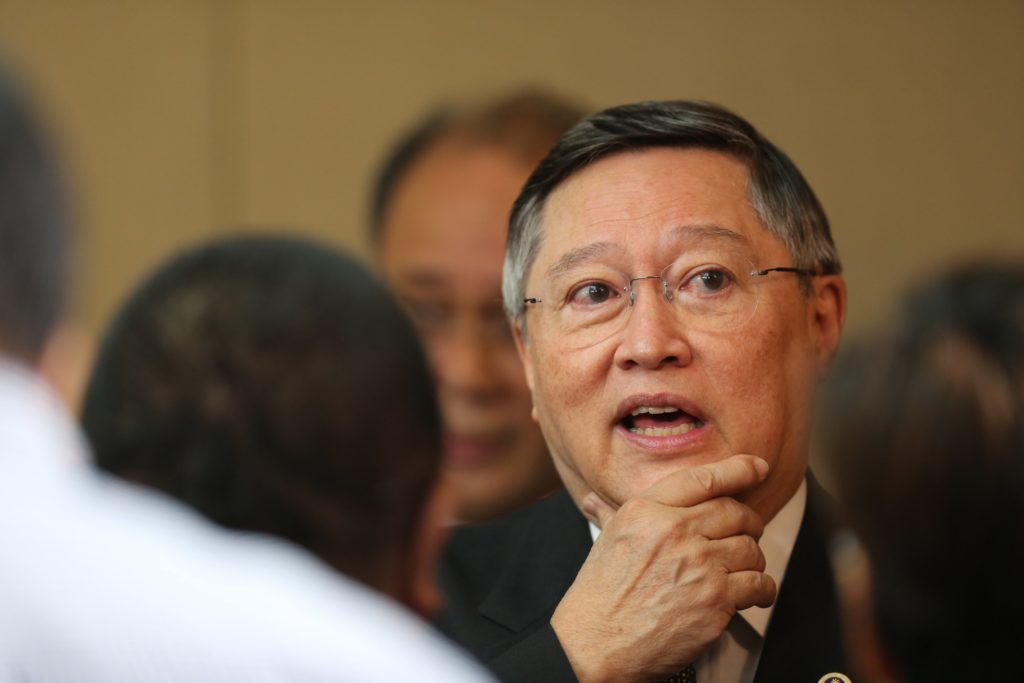DOF: AIIB to approve first PH project soon

Finance Secretary Carlos G. Dominguez III (Presidential Photographers Division)
MANILA — The Philippines expects approval of the first project it pitched for co-financing with the Asian Infrastructure Investment Bank in the coming weeks while Manila presses the China-led lender to also show it can finance projects on its own.
Finance Secretary Carlos G. Dominguez III, who will attend the AIIB’s 2017 annual meeting on June 16-18 in South Korea, said he wanted to know “what are their plans in the future because right now, the AIIB is just co-financing projects.”
“What are their future plans for developing their own capacity?” Dominguez told reporters when asked what would be his agenda at the upcoming meeting.
Also, Dominguez said he wanted to see “what kind of conditions they will impose so that we will know whether their terms are acceptable to us as a borrower.”
Dominguez said they have been expecting within the next six weeks the AIIB’s approval of its planned co-financing with the World Bank of the $500-million Metro Manila Flood Management Project.
Article continues after this advertisementLast month, the National Economic and Development Authority’s Investment Coordination Committee approved the plan to have the project co-financed by the two multilateral lenders, as it was earlier intended only for World Bank financing.
Article continues after this advertisementThe change in the financing scheme will be up for President Duterte’s approval at a NEDA Board meeting tentatively scheduled later in June.
Documents showed that the Philippines last February sought funding of $150 million from the AIIB.
The government was eyeing to source another $150 million from the World Bank, $192.6 million from the national budget, and $7.4 million from the Global Environmental Facility.
The AIIB board is expected to consider for approval its counterpart funding for the project this June, documents have shown.
The project will be implemented by the Department of Public Works and Highways, the Department of Environment and Natural Resources, as well as the Metro Manila Development Authority.
Implementation period was set from July this year until December 2023.
The project was aimed at improving flood management in selected Metro Manila areas “by constructing new and modernizing existing selected pumping stations and their supporting infrastructure, by improving solid waste management practices within the vicinity of drainage systems served by the selected pumping stations, and by supporting the
resettlement of project affected people.”
“The project will focus on about 56 potentially critical drainage areas with an approximate land area of 11,100 hectares or over 17 percent of the total area of Metro Manila. This will include an area covered by new pumping stations of about 2,900 hectares, with a total population of about 970,000 people or about 210,000 households,” the project summary information read.
“The Philippines is highly vulnerable to natural disasters with exceptionally high exposure to cyclones and floods. The country, on average, is struck by 20 cyclones every year causing widespread flooding across the country including Metro Manila,” the document noted.
“The government of the Philippines—after the widespread destruction caused by tropical storm ‘Ondoy’ (internationally named Ketsana) in 2009—stepped up its efforts to improve flood management in Manila to make it a safer place for its inhabitants. A comprehensive flood management master plan for the greater Metro Manila area was prepared and approved by [the Philippine government] in 2012 recommending a set of structural, non-structural and institutional measures for implementation. Urban drainage, a crucial element in the city’s master plan, relies on a combination of drainage channels, waterways and pumping stations,” according to the document.
“[The Philippine government] has already initiated the implementation of the master plan with the priority activities that can be implemented quickly. This includes cleaning and dredging of water ways, river bank protection and modernization of some of pumping stations. But these activities need to be scaled up and some of the larger and more complicated priority structural and non-structural measures have to be taken up with the support of development partners,” the document said.
“The World Bank will be the lead financier of the project and will administer the [AIIB’s] loan on behalf of the bank, including procurement, disbursements, environmental and social compliance, and project monitoring and reporting,” it added. SFM